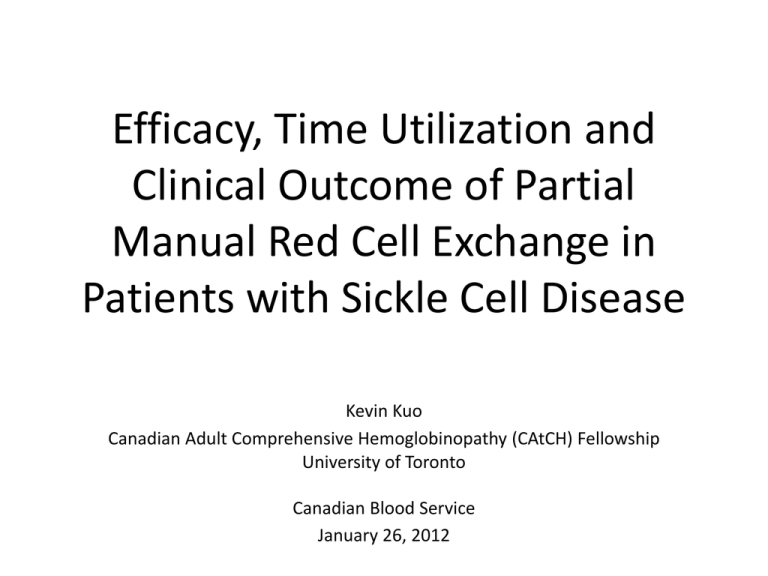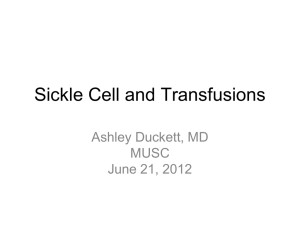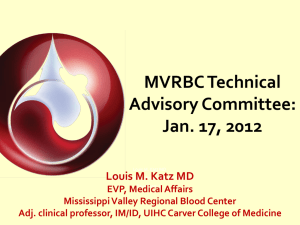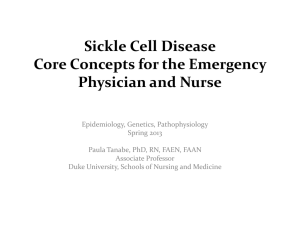RBCX_CBS_Kuo_final
advertisement

Efficacy, Time Utilization and Clinical Outcome of Partial Manual Red Cell Exchange in Patients with Sickle Cell Disease Kevin Kuo Canadian Adult Comprehensive Hemoglobinopathy (CAtCH) Fellowship University of Toronto Canadian Blood Service January 26, 2012 Outline • Indications, rationale and evidence for transfusion in Sickle Cell Disease • Compare and contrast different transfusion techniques: top-up/simple, exchange (automated, partial manual) • Results of the retrospective cohort study on PMXC – – – – – Laboratory and clinical efficacy Iron balance Time utilization Adherence Adverse events • Discussions and Future Directions Case • 18 year-old female with Sickle Cell Disease (Hb SS) • Frequent painful vaso-occlusive crises, renal tubular acidosis, osteoporosis with fracture, growth hormone deficiency with developmental delay • Started on simple transfusion at age 12 for elevated transcranial Doppler velocity • Developed severe transfusional iron overload • New narrowing of left ICA found on MRA in 2010 • New progressive neurological symptoms in the past few months (memory loss, focal headaches) Sickle Cell Disease • Encompasses SS, SC, S/b0thal, S/b+thal, S/D, S/CHarlem, S/OArab, C/SAntilles, S/Quebec-CHORI, A/SOman • Mutation in the 6th codon of the HBB gene • From Glutamic acid to Valine • Ethnic distribution coincide with the malaria belt • Heterozygote advantage vis-à-vis malaria • 1/20 blacks are carriers • 1/400 blacks are homozygotes or compound heterozygotes • The first human monogenic disorder described Spectrum of SCD Complications These mechanisms are not mutually exclusive Rationale for Transfusion in SCD • Corrects anemia – Increases O2 carrying capacity • Decreases the proportion of Hb S carrying erythrocytes – Reduces blood viscosity by RBC exchange • Suppresses erythropoiesis (HbS synthesis) • Reduces hemolysis Marouf R. Blood transfusion in sickle cell disease. Hemoglobin. 2011;35(5-6):495-502 Rees DC, Williams TN, Gladwin MT. Sickle-cell disease. Lancet. 2010 Dec 11;376(9757):2018-31 Evidence for Transfusion in SCD Indication Stroke 1° prevention 2° prevention Surgery (pre-operative) Acute chest syndrome: Preventive Study STOP, STOP2 (high TCD) SIT (SCI patients) SWiTCH 1 CSSCD Pegelow, et al., 1995 Vichinsky, et al. 1995 Al-Jaouni, et al. 2006 2 TAPS Styles et al., 2007 STOP 3 Treatment NACSSG 4 Emre, et al., 2005 Turner, et al., 2009 Mallouh, et al., 1998 Pregnancy (on-demand) Koshy, et al., 1988 Renal concentrating defect Statius van Eps, et al. 1967 Symptomatic anemia Methodology RCT RCT (ongoing) RCT Prospective cohort Retrospective cohort RCT RCT RCT RCT Secondary analysis of RCT Prospective cohort Prospective cohort Retrospective cohort Retrospective cohort RCT Clinical trial? Other Indications for Transfusion • Chronic ischaemic hepatic sequestration • Chronic renal failure related to sickle cell disease (biopsy proven) • Recurrent retinal infarction • Chronic leg ulcers not amenable to standard therapy • Recurrent painful VOC not controlled by hydroxyurea and conservative strategies • Recurrent priapism not responding to therapy • Complicated, twin, IUGR pregnancies Methods of Transfusion • Simple “top-up” transfusion • Exchange transfusion: – Automated exchange – Partial Manual RBC Exchange Transfusion (PMXC) Why Exchange Transfusion? Sickle Cell, Transfusion, Viscosity • Viscosity is a function of cell concentration (hematocrit), deformability and aggregation of the cells (sickle and normal RBCs) and viscosity of the suspending medium (plasma) • Early observation that reduction of Hb S to < 25 to 50% can prevent SCD complications • Transfusion to Hct > 0.35 worsened existing strokes or created new ones Schmalzer EA, Lee JO, Brown AK, Usami S, Chien S. Viscosity of mixtures of sickle and normal red cells at varying hematocrit levels. Implications for transfusion. Transfusion. 1987;27:228–233 O2 delivery Sickle Cell, Viscosity, O2 Delivery Schmalzer, et al. 1987 Sickle Cell, Viscosity and Transfusion Hct = 0.200 HbS = 100% Hct = 0.350 HbS = 14% Sickle Hct O2 delivery Exchange transfusion Simple transfusion Hct = 0.350 HbS = 57% Shear rate and pO2 comparable to the microcirculation Goals of RBC Exchange Transfusion • • • • Reduce hemoglobin S level Reduce blood viscosity Improve oxygen carrying capacity Maintain iron balance Automated versus Partial Manual RBCX • • • • • • • Automated Very effective at rapidly reducing Hb S < 30% Maintains Hb S < 30% More blood Resource demanding Apheresis nurse and equipment Central venous access Anticoagulation for CVC Partial Manual • Less blood exposure (2 – 3 U pRBC) • Can be achieved with peripheral veins • Risk of hypotension and symptomatic anemia during phlebotomy • Both methods can maintain iron balance Efficacy, Time Utilization and Clinical Outcome of PMXC in SCD Patients Rationale for the study • Scant data on cost, outcomes and adverse events • How effective is PMXC at achieving prespecified HbS and Hct targets? • What are the clinically-relevant outcomes? • How frequent are the adverse events? What are they? • Can PMXC maintain iron balance? • How compliant are patients on PMXC? PMXC Method • Exchange frequency: 4 to 6 weeks • Each PMXC session: 2 x 500cc phlebotomy with 500cc NS infusion in between, then 2U pRBCs • Procedure was repeated until pre-RBCX hemoglobin A (HbA) level >50% was reached • Phlebotomy was reduced or omitted during episodes of symptomatic anemia at the discretion of the treating hematologist • Patients with poor venous access had indwelling line with chronic, therapeutic anticoagulation against line-related thrombosis Relaxation of Pre-transfusion HbS Target to < 50% • (recall that for stroke prophylaxis pretransfusion HbS target is < 30%) • Cohen, et al. (1992) retrospective cohort study • 15 patients with history of stroke but no recurrence for at least 4 years • Pre-transfusion Hb S maintained at < 50% • Median duration of follow-up: 84 months (14 to 130 months) • No recurrent stroke during follow-up Methods • • • • Single-center retrospective cohort April 1, 2010 to April 30, 2011 (13 mo) Iron balance: ferritin level Non-adherence to treatment: missing at least one session unrelated to medical events (e.g. hospital admission) • Statistical analysis: descriptive statistics, t-test for continuous variables, Fishers exact test for categorical variables Results – Patient Characteristics • • • • • • 19 patients 176 RBC exchange sessions Phenotype: 16 HbSS, 2 HbSC, 1 HbSD Median age: 27 years-old 6 male, 13 female None of the patients had an overt stroke in the past 4 years Indications for PMXC Pulmonary hypertension (confirmed by cardiac catheterization) 1 Painful VOC refractory to or intolerant of hydroxyurea 3 Prevention of intrahepatic cholestasis in liver allograft 1 Neurological Elevated TCD (n = 3) Silent cerebral infarct (n = 2) Transient Ischemic Attack (n = 1) Stroke (n = 10) Moyamoya (n = 3) Seizure (n = 2) Amaurosis Fugax (n = 1) 13* Ability of PMXC to Achieve Prespecified Hematologic Endpoints Proportion of PMXC sessions with: HbSS HbSC or SD Post-RBCX Hct <0.300 77% (97/126) 0% (0/30) Pre-RBCX HbA >0.500 67% (73/109) 4% (1/26) Variability in Attaining Target Hct and HbA Reasons for Not Achieving Target HbA Level Reasons N Sessions HbSC or HbSD phenotype 3 25 Non-adherence to treatment 6 15 Exchange interval >4.0 weeks 11 Reduced or no phlebotomy in previous session 5 Not on transfusion prior to starting PMXC No identifiable cause 1 1 5 Adherence and Efficacy of PMXC Recurrent complications Adherent Not Adherent Yes 0 3 No 13 3 Painful VOC (n = 2) Moyamoya-like changes (n = 1) PMXC and Iron Balance # Not adherent to RBCX * Not on iron chelation Adverse Events • 2 transfusion-related events – fever, pruritis • 2 phlebotomy-related events – pre-syncope, nausea • 25 partial/cancelled phlebotomy sessions: – – – – – 11 Symptomatic anemia prior to phlebotomy 1 Inadequate time to complete procedure 5 Poor/lost venous access 1 Active GI bleed 7 No reason documented Time Utilization with PMXC P = 0.759 55 ± 30 P = 0.987 53 ± 37 88 ± 20 88 ± 23 Comparison with the Literature • Cabibbo S, et al. 2005 • 20 SCD patients, manual (n= 7) and automatic (n = 13) exchanges • 394 exchanges over 6 years • Single-donor units to minimize alloimmunization • Prophylactically matched for Rh(C,c,E,e) and Kell • Did not specify the PMXC protocol • Patients were put on PMXC “because of poor compliance with the cell separator or difficult venous access” Cabibbo S, Fidone C, Garozzo G, et al. Chronic red blood cell exchange to prevent clinical complications in sickle cell disease. (2005) Transfusion and Apheresis Science 32:315-21 Comparison with the Literature • Target: pre-XC HbS <60%, post-XC HbS <30%, Hct > 0.300 • Mean RBC consumption: – 6.1 units for automatic XC – 1.8 units for PMXC (comparable to our data) • 0% alloimmunization rate, 1 episode of hemolytic transfusion reaction Cabibbo S, Fidone C, Garozzo G, et al. Chronic red blood cell exchange to prevent clinical complications in sickle cell disease. (2005) Transfusion and Apheresis Science 32:315-21 Summary • Patients who are adherent on PMXC: – can maintain a pre-RBCX HbS <50% with good clinical outcomes, – low rates of adverse events, – reduced blood consumption compared to automated RBCX, – obviate the need for ongoing iron chelation in those without pre-existing iron overload • In patients with iron overload, PMXC with iron chelation therapy can maintain iron balance Summary • In patients with good peripheral venous access, indwelling lines do not confer an advantage to the speed of phlebotomy or transfusion • Patient with pre-RBCX HbS level >50% may benefit from a single session of automated RBCX to “reset” their HbS level before commencing PMXC Limitations • Single-centered study • Retrospective in nature • Small sample size – precludes multivariable and subgroup analysis • Volume of phlebotomy should be recorded rather than in “units” • Ideally, changes in iron burden should be measured in liver iron concentration as assessed by Ferriscan • Iron chelation acted as moderator in assessment of iron balance Future Directions • Prospectively determine the rate of new or progressive silent infarcts, vasculopathy and reduction of iron burden via partial manual RBCX • Retrospectively and prospectively compare the outcomes of patients on automatic and partial manual exchange transfusions • Examine the kinetics of HbS and Hct recovery in these 2 groups to determine the “optimal” interval of exchange • Develop guidelines to optimize the exchange parameters in these patients References • • • • • • • • • • • Hirst C, Williamson L. Preoperative blood transfusions for sickle cell disease. Cochrane Database Syst Rev. 2012 Jan 18;1:CD003149. Mahomed K. Prophylactic versus selective blood transfusion for sickle cell anaemia during pregnancy. Cochrane Database Syst Rev. 2000;(2):CD000040. Pegelow CH, Adams RJ, McKie V, et al. Risk of recurrent stroke in patients with sickle cell disease treated with erythrocyte transfusions. J Pediatr. 1995 Jun;126(6):896-9 Styles LA, Abboud M, Larkin S, Lo M, Kuypers FA. Transfusion prevents acute chest syndrome predicted by elevated secretory phospholipase A2. Br J Haematol. 2007 Jan;136(2):343-4. Epub 2006 Nov 30. Vichinsky EP, Neumayr LD, Earles AN, et al. Causes and outcomes of the acute chest syndrome in sickle cell disease. National Acute Chest Syndrome Study Group. N Engl J Med. 2000 Jun 22;342(25):1855-65. Turner JM, Kaplan JB, Cohen HW, Billett HH. Exchange versus simple transfusion for acute chest syndrome in sickle cell anemia adults. Transfusion. 2009 May;49(5):863-8. Epub 2009 May 1. Emre U, Miller ST, Gutierez M, Steiner P, Rao SP, Rao M. Effect of transfusion in acute chest syndrome of sickle cell disease. J Pediatr. 1995 Dec;127(6):901-4. Mallouh AA, Asha M. Beneficial effect of blood transfusion in children with sickle cell chest syndrome. Am J Dis Child. 1988 Feb;142(2):178-82. Miller ST, Wang WC, Iyer R, Rana S, Lane P, Ware RE, Li D, Rees RC; BABY-HUG Investigators. Urine concentrating ability in infants with sickle cell disease: baseline data from the phase III trial of hydroxyurea (BABY HUG). Pediatr Blood Cancer. 2010 Feb;54(2):265-8. Koshy M, Burd L, Wallace D, Moawad A, Baron J. Prophylactic red-cell transfusions in pregnant patients with sickle cell disease. A randomized cooperative study. N Engl J Med. 1988 Dec 1;319(22):1447-52. Cho G, Hambleton IR. Regular long-term red blood cell transfusions for managing chronic chest complications in sickle cell disease. Cochrane Database Syst Rev. 2011 Sep 7;9:CD008360. Supplementary Materials Acute Indications for RBC Exchange • • • • • • • Acute ischaemic/haemorrhagic stroke Acute retinal infarction Severe acute chest syndrome 1 Sickle cell hepatopathy Priapism 2 Multiorgan failure Pre-operative cardiovascular, intrathoracic, retinal, neuro-spinal surgery 3 Acute Indications for RBC Exchange • • 1, 2: RBC exchange generally indicated for clinical deterioration despite standard therapy (hydration, simple transfusion, oxygenation, pain control, antibiotics) 3: In the Preoperative Transfusion Sickle Cell Study: – Pre-op patients were randomized to: • simple transfusion (target Hb 90 – 110) versus • aggressive transfusion (target Hb 90 – 110 AND HbS < 30%, 73% of the participants achieved the target by RBC exchange) (Vichinsky 1995) – frequency of serious complications was similar between the two groups • Nonetheless, many clinicians still perform RBC exchange for “risky” surgeries such as cardiovascular, intrathoracic, or joint replacement surgeries, especially in older patients and those with significant comorbidities (Swerdlow 2006) Swerdlow PS. Red Cell Exchange in Sickle Cell Disease. Hematology 2006 p.48-53 Vichinsky EP, Haberkern CM, Neumayr L, et al. A comparison of conservative and aggressive transfusion regimens in the perioperative management of sickle cell disease. The Preoperative Transfusion in Sickle Cell Disease Study Group. N Engl J Med. 1995 Jul 27;333(4):206-13 Vichinsky EP, Neumayr LD, Haberkern C, et al. The perioperative complication rate of orthopedic surgery in sickle cell disease: report of the National Sickle Cell Surgery Study Group. Am J Hematol. 1999 Nov;62(3):129-38 STOP and STOP2 Study STOP Study • Chronic transfusion with a pretransfusion Hb S < 30% is effective in preventing stroke in SCD patients with high TCD (>200 cm/s) compared no transfusion STOP2 Study • Discontinuation of transfusion for SCD patients with elevated transcranial Doppler velocity results in a reversion to high rate of stroke Transfusion is currently the only effective primary and secondary prophylactic agent against stroke • • • • RR = 0.097 ARR = 0.015 RRR = 0.903 NNT = 67 Pre-Operative Transfusion Reduces Serious Adverse Events in Patients with Sickle Cell Disease (SCD): Results From the Transfusion Alternatives Preoperatively in Sickle Cell Disease (TAPS) Randomised Controlled Multicentre Clinical Trial • • • • • Jo Howard, Moira Malfroy, Llewelyn Charlotte, Louise Choo, David Rees, Isabeau Walker, Tony Johnson, Louise Tillyer, Karin Fijnvandraat, Melanie Kirby-Allen, Renate Hodge, Shilpi Purohit, Sally C. Davies, and Lorna M Williamson Introduction: The rate of complications after surgery is increased in patients with Sickle Cell Disease (SCD) and pre-operative blood transfusion has historically been used to decrease this risk. Observational studies and one limited Randomised Controlled Trial (RCT) have suggested that in some patients, transfusion can safely be omitted. Since transfusion is associated with complications including alloimmunisation and increased post-operative infections, we performed a RCT to address whether overall peri-operative complications in SCD are reduced by pre-operative transfusion. Methods: TAPS was a Phase III multicentre, pragmatic, randomised controlled trial with a parallel group sequential superiority design, carried out between November 2007 and March 2011 at 22 sites in the UK, Netherlands and Canada. Eligible patients had HbSS or HbSβ°thal, were aged one year or more and were having low risk (eg adenoidectomy, dental surgery) or medium risk (eg joint replacement, cholecystectomy, tonsillectomy) elective surgery. Patients were excluded if they had a haemoglobin (Hb) <6.5g/dl, had received a blood transfusion within the last 3 months or had severe SCD. Patients were randomly assigned to Arm A, which received no pre-operative transfusion, or Arm B, which received a top-up transfusion if Hb<9g/dl or a partial exchange if Hb9g/dl. Sites followed their own standards for all other aspects of perioperative care, although guidance was provided. The primary outcome was all significant complications between randomisation and 30 days post surgery as defined in the protocol. These were sent blinded to the End-Point Review Panel for final classification. Complications which were life-threatening, or resulted in death or persistent or significant incapacity/disability and other important medical events were also recorded as Serious Adverse Events (SAEs) and were reviewed by an Independent Data Monitoring Committee (IDMC). Due to a major imbalance in the number of SAEs between treatment groups, the trial was terminated early following an IDMC recommendation. Results: 333 patients were screened for the trial and 70 patients were randomised at the time the trial was terminated. Thirty three completed 30 day follow up in Arm A and 34 in Arm B. Both groups were comparable with respect to age, gender, severity of SCD, type of surgery and baseline Hb. Only 13 patients had low risk surgery. The pre-operative (posttransfusion) Hb was higher in Arm B (9.7g/dl vs 7.7g/dl) and 5 patients in Arm B received partial exchange transfusion with a mean pre-operative HbS% of 47.2%. There were no differences in peri-operative management, including fluid support and oxygen therapy, between the two groups. There were 11 SAEs (33%) in patients who did not receive a pre-operative transfusion, compared to only 1 SAE (3%) in patients who did receive a top-up transfusion or partial exchange. Eleven of the SAEs were Acute Chest Syndrome (ACS). PMXC Method - Swerdlow, 2006 • A. Calculate exchange volume as 1.5 red cell volumes. • B. Red cell volume = hematocrit × total blood volume. – a. Assume total blood volume is 70 cc/kg if over 20 kg, 85 cc/kg if under 20 kg. – b. Each standard unit has a red cell volume of ~200 cc • (Hct ~40 × 500 cc) • C. Perform adult manual exchange as follows: – 1. Bleed 500 cc and then infuse 500 cc saline – 2. Bleed 500 cc and then infuse 2 units packed red cells – 3. Repeat steps 1 and 2 until volume of packed cells administered is equal to planned exchange volume (up to three or even four repeats for large adults) • For pediatric patients, use smaller comparable volumes (such as 5-10 cc/kg for bleeds and saline and calculate red cell volume based on 1- to 1.25-fold the amount of blood removed in bleeds).







